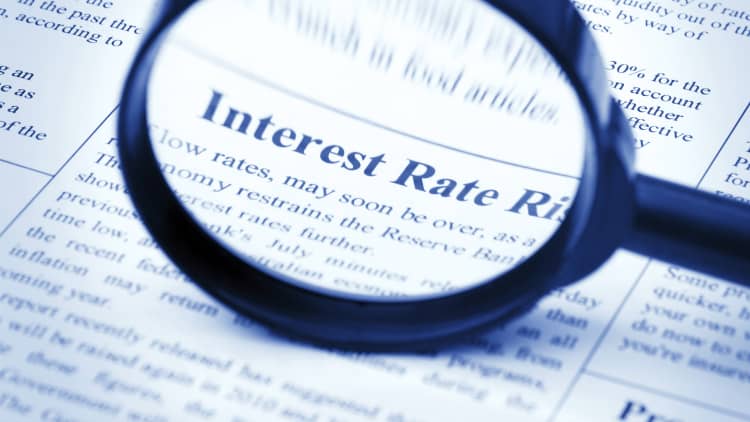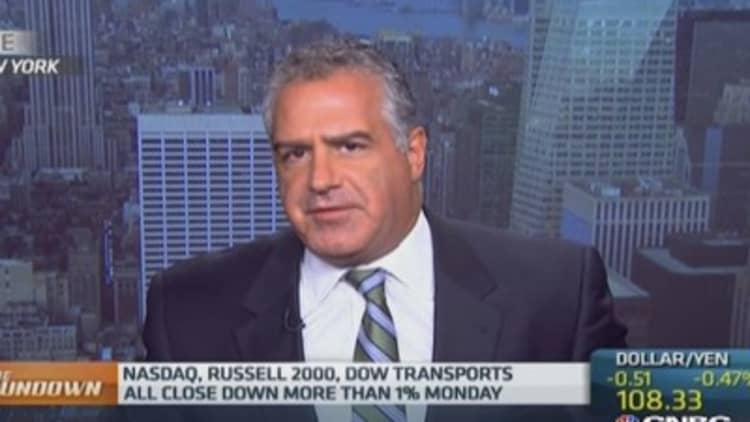
Hindsight is a wonderful thing, especially when it comes to explaining market crashes. Six times in the past 50 years US equities dropped more than 30 per cent in 12 months. After most of them investors looked back at glaring warning signs and were baffled that they missed them. If the S&P 500 were to plunge from 2,000 to 1,400 in the next year, what screaming sell signals would future generations gaze at in the history books and wonder at our ability to ignore the obvious?
Read MoreCramer:Don't misunderstand Monday's selloff
• Leveraged loans to private equity are not just flashing red but have a wailing siren and a man walking in front waving a flag. The loans are even bothering the see-no-evil officials at the Federal Reserve, who have been trying to persuade banks that excessively leveraged loans are risky.
More than a third of leveraged loans this year have lent more than six times earnings before interest, tax, depreciation and amortization, only slightly below the proportion at the peak of the 2007 credit bubble, according to S&P Capital IQ.
More from Financial Times:
Universities to revamp economics courses
Tesco parachutes in new finance director early
Eurozone recovery stutters in September
Bank exuberance is shown by loans with less lender protection than usual. The proportion of "covenant light", or cov-lite, loans is above 60 per cent, the highest ever. If and when things go wrong, it will be harder for lenders to demand their money back.
• Junk bonds may be known as high yield but offer an extraordinarily low yield. The benchmark Merrill Lynch index yields 6.3 per cent, lower than any time before April – although after a summer wobble it is up from the record low of 5.7 per cent in June.
Read MoreTime to worry? Russell 2000 hits 'death cross'
The spread over government bonds, reflecting the extra reward for the risk of lending money to the companies with the lowest credit ratings, is still below 4 percentage points, too. This is not at all-time lows, but a rise in the default rate from its near-record low below 2 per cent towards the average since 1993 of 4.5 per cent would be disastrous for investors.

Buyers of junk bonds are loosening the purse strings in a similar way to those in leveraged loans. Last year was the best for risky payment-in-kind bonds (where interest can be rolled up) since 2008, although they make up a smaller proportion of what is now a far larger junk market.
• A boom in flotations is running at a pace not seen since the dotcom bubble burst. Companies are rushing to raise money, and the quality of the protections being offered to shareholders has declined markedly in the hottest sectors of biotechnology and dotcoms. Friday's Alibaba offering, the biggest-ever US IPO, has experienced phenomenal demand for shares that give investors zero say in how the company is run or who it is run by. Shareholders will not even own some of the vital operating assets.
Typically companies choose to sell themselves when investors are overexcited. When a sector is in great demand, entrepreneurs find ways to create supply: more and more companies are created from scratch or carved out of existing businesses until prices tumble. The longer this goes on, the lower the quality of the new companies. Only with hindsight will we know if this has gone on too long.
Read MoreGartman: This is a 'treacherous, nasty trade'
• Alongside the IPO boom, a wave of takeovers looks similar to 2000 and 2007. Takeovers are largely financed by debt, as companies see bonds as even more overpriced than equity, and so easy to sell.
• As companies gear up to buy shares in rivals, they are also borrowing to buy shares in themselves. Both takeovers and buybacks reduce the share count, pushing up prices and making earnings per share grow faster at the expense of the balance sheet.
Overall, Société Générale points out that companies are borrowing more than at the 2007 peak and buying back about the same, although cash flows are a little stronger now (perhaps because super-low rates are keeping down borrowing costs).
Investors are rewarding corporate buybacks. The S&P 500 Buyback index, which measures the 100 stocks buying back the most, outperformed the S&P by 4 percentage points over the past 12 months, about equal to its outperformance in the period up to June 2007, when the credit crunch began – although this is down from the 16 point outperformance last year.

• Everything in the US is expensive. Valuation is no guide to short-term returns, but big losses almost always come when the market is overpriced. Even using Wall Street's favoured measure, the multiple of price to estimated operating earnings, shares are more expensive than in 2007 or 1987. The forward PE has been more expensive only during the dotcom bubble and its aftermath.
• The Fed will end support for markets next month when it stops buying bonds. It is also discussing when to end the longest period of low rates in history, and many – including central bankers – have been warning of the danger that preparation for rate rises may bring higher market volatility, and so lower prices.
Read MoreToo high? Cramer on Alibaba, & other new stocks
Many investors have bought shares because bonds offer such meaningless yields. A sharp rise in yields is likely to persuade some to switch back, hurting demand for shares just as companies are finding it harder to borrow to buy back.
Yet central bankers might keep yields down, or markets may prefer rose-tinted spectacles to the benefit of hindsight. The warnings are clear, but history teaches that markets can ignore sell signals for years. Only with hindsight can we know for sure.
—By James Mackintosh, Financial Times

